Lexus RX 350 Navigation Manual
RX350_Navi_U (L/O 0601)
Introduction
Thank you for your purchase of the Navigation System. Please read this manual carefully to ensure proper use. Keep this manual in your vehicle at all times.
The Navigation System is one of the most technologically advanced vehicle accessories ever developed. The system receives satellite signals from the Global Positioning System (GPS) operated by the U.S. Department of Defense. Using these signals and other vehicle sensors, the system indicates your present position and assists in locating a desired destination.
The navigation system is designed to select efficient routes from your present starting location to your destination. The system is also designed to direct you to a destination that is unfamiliar to you in an efficient manner. The system uses DENSO maps. The calculated routes may not be the shortest nor the least traffic congested. Your own personal local knowledge or “short cut” may at times be faster than the calculated routes.
The navigation system’s database includes about 75 Point of Interest categories to allow you to easily select destinations such as restaurants and banks. If a destination is not in the database, you can enter the street address or a major intersection close to it and the system will guide you there.
The system will provide both a visual map and audio instructions. The audio instructions will announce the distance remaining and the direction to turn in approaching an intersection. These voice instructions will help you keep your eyes on the road and are timed to provide enough time to allow you to maneuver, change lanes or slow down.
i
2007 RX350 Navigation from Jan. ’06 Prod. (OM48624U)

RX350_Navi_U (L/O 0601)
Please be aware that all current vehicle navigation systems have certain limitations that may affect their ability to perform properly. The accuracy of the vehicle’s position depends on the satellite condition, road configuration, vehicle condition or other circumstances. For more information on the limitations of the system, refer to pages 286 through 287.
ii
2007 RX350 Navigation from Jan. ’06 Prod. (OM48624U)
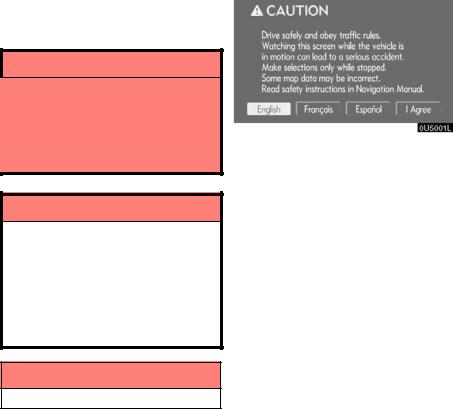
RX350_Navi_U (L/O 0601)
Important information about |
|
this manual |
Safety Instruction |
For safety reasons, this manual indicates items requiring particular attention with the following marks.
 CAUTION
CAUTION
This is a warning against anything which may cause injury to people if the warning is ignored. You are informed about what you must or must not do in order to reduce the risk of injury to yourself and others.
NOTICE
This is a warning against anything which may cause damage to the vehicle or its equipment if the warning is ignored. You are informed about what you must or must not do in order to avoid or reduce the risk of damage to your vehicle and its equipment.
INFORMATION
This provides additional information.
iii
To use this system in the safest possible manner, follow all the safety tips shown below.
This system is intended to assist in reaching the destination and, if used properly, can do so. The driver is solely responsible for the safe operation of your vehicle and the safety of your passengers.
Do not use any feature of this system to the extent it becomes a distraction and prevents safe driving. The first priority while driving should always be the safe operation of the vehicle. While driving, be sure to observe all traffic regulations.
Prior to the actual use of this system, learn how to use it and become thoroughly familiar with it. Read the entire Navigation System Owner’s Manual to make sure you understand the system. Do not allow other people to use this system until they have read and understood the instructions in this manual.
For your safety, some functions may become inoperable when driving. Unavailable touch−screen buttons are dimmed. Only when the vehicle is not moving, can the destination and route selection be done.
2007 RX350 Navigation from Jan. ’06 Prod. (OM48624U)
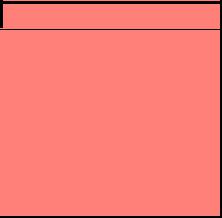
RX350_Navi_U (L/O 0601)
 CAUTION
CAUTION
DFor safety, the driver should not operate the navigation system while he/she is driving. Insufficient attention to the road and traffic may cause an accident.
DWhile driving, be sure to obey the traffic regulations and maintain awareness of the road conditions. If a traffic sign on the road has been changed, route guidance may provide wrong information such as the direction of a one way street.
While driving, listen to the voice instructions as much as possible and glance at the screen briefly and only when it is safe. However, do not totally rely on voice guidance. Use it just for reference. If the system cannot determine the current vehicle position correctly, there is a possibility of incorrect, late, or non−voice guidance.
The data in the system may occasionally be incomplete. Road conditions, including driving restrictions (no left turns, street closures, etc.) frequently change. Therefore, before following any instruction from the system, look to see whether the instruction can be done safely and legally.
This system cannot warn about such things as the safety of an area, condition of streets, and availability of emergency services. If unsure about the safety of an area, do not drive into it. Under no cir-
cumstances is this system a substitute for the driver’s personal judgement.
Use this system only in locations where it is legal to do so. Some states/provinces may have laws prohibiting the use of video and navigation screens next to the driver.
iv
2007 RX350 Navigation from Jan. ’06 Prod. (OM48624U)
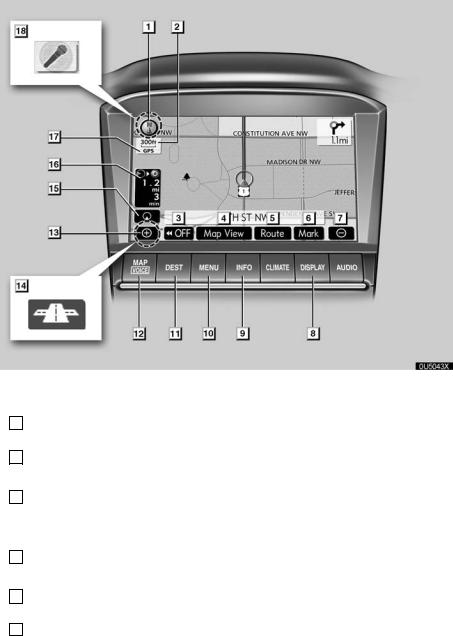
Quick guide —
— Overview buttons and guidance screen
No. |
Name |
Function |
Page |
|
|
North−up or |
This symbol indicates a map view with |
|
|
1 |
heading−up |
north−up or heading−up. Touching this |
16 |
|
|
symbol |
symbol changes the map orientation. |
|
|
|
|
|
|
|
2 |
Scale indicator |
This figure indicates the map scale. |
14 |
|
|
|
|
|
|
|
|
Touch this button to obtain a broader |
|
|
3 |
“AAOFF” |
view. Some of the buttons on the screen |
86 |
|
are not displayed. They are displayed |
||||
|
|
|
||
|
|
again by touching “ON""”. |
|
|
|
|
|
|
|
|
|
Touch this button to browse information |
|
|
4 |
“Map View” |
about guidance route, to set the Points |
56, 59, 60, 61 |
|
of Interest to be displayed on the |
||||
|
|
|
||
|
|
screen, or to record the route. |
|
|
|
|
|
|
|
5 |
“Route” |
Touch this button to change the route. |
50, 52 |
|
|
|
|
|
|
|
“Mark” |
Touch this button to register the current |
|
|
6 |
position or the cursor position as a |
9 |
||
|
|
memory point. |
|
|
|
|
|
|
v

No. |
Name |
Function |
|
Page |
|
|
Zoom out |
Touch this button to reduce the map |
|
||
7 |
touch−screen |
14 |
|||
scale. |
|
||||
|
button |
|
|
||
|
|
|
|
||
|
|
|
|
||
8 |
“DISPLAY” |
Push this button to display the “Display” |
155 |
||
button |
screen. |
|
|||
|
|
|
|||
|
|
|
|
|
|
|
“INFO” button |
Push this button to display the “Informa- |
2, 96, 99, 103, |
||
9 |
108, 157, 160, |
||||
tion” screen. |
|
||||
|
|
|
162 |
||
|
|
|
|
||
|
|
|
|
|
|
|
“MENU” button |
Push this button to display the “Menu” |
vii, ix, 64, |
||
10 |
66, 67, 68, 70, |
||||
screen. |
|
||||
|
|
|
83, 298 |
||
|
|
|
|
||
|
|
|
|
||
11 |
“DEST” button |
Push this button to display the “Destina- |
xi, xii, 18, |
||
tion” screen. |
|
19 |
|||
|
|
|
|||
|
|
|
|
||
|
“MAP/VOICE” |
Push this button to repeat a voice guid- |
|
||
12 |
ance, cancel one touch scroll, |
start |
8, 48 |
||
button |
guidance, and display the current posi- |
||||
|
|
||||
|
|
tion. |
|
|
|
|
|
|
|
|
|
|
Zoom in |
Touch this button to magnify the map |
|
||
13 |
touch−screen |
14 |
|||
scale. |
|
||||
|
button |
|
|
||
|
|
|
|
||
|
|
|
|
|
|
|
Foot print map |
Touch this button to display the foot print |
|
||
14 |
touch−screen |
15 |
|||
map and the building information. |
|
||||
|
button |
|
|
||
|
|
|
|
||
|
|
|
|
|
|
|
Screen |
|
|
|
|
15 |
configuration |
Touch this button to change the screen |
12 |
||
touch−screen |
mode. |
|
|||
|
|
|
|||
|
button |
|
|
|
|
|
|
|
|
||
16 |
Distance and time |
Displays the distance, the estimated |
49 |
||
to destination |
travel time to the destination, and the |
||||
|
estimated arrival time at the destination. |
|
|||
|
|
|
|||
|
|
|
|
||
|
“GPS” (Global |
Whenever the vehicle is receiving sig- |
|
||
17 |
Positioning |
nals from the GPS, this mark is dis- |
286 |
||
|
System) mark |
played. |
|
|
|
|
|
|
|
||
|
Speech |
The microphone is shown by pushing |
|
||
|
the speech command switch. |
The |
|
||
18 |
command system |
152 |
|||
|
indicator |
speech command system can be oper- |
|
||
|
ated while this indicator is shown. |
|
|
||
|
|
|
|
||
|
|
|
|
|
|
vi
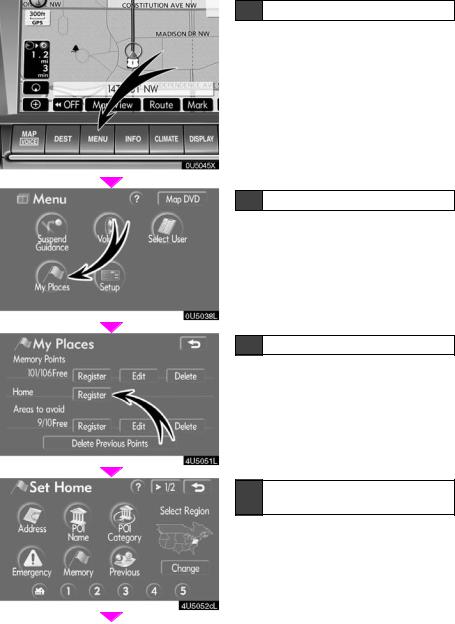
— Registering home
1 Push “MENU” button.
2 Touch “My Places”.
3 Touch “Register” of the home.
4 There are 13 different methods to search your home.
See “Destination search” on page 19.
vii
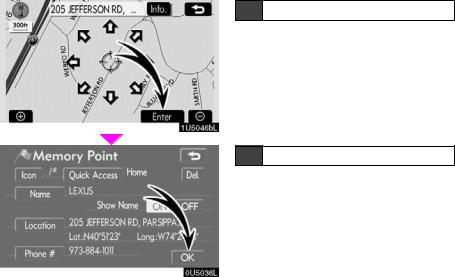
5 Touch “Enter”.
The “Memory Point” screen is displayed.
6 Touch “OK”.
Registration of home is complete.
You can change the icon, quick access, name, location and phone number. (See “
— Editing memory points” on page 72.)
viii
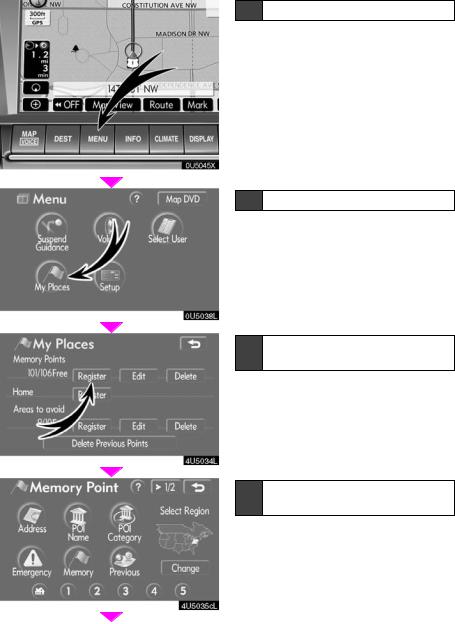
— Registering preset memory point (Quick access)
1 Push “MENU” button.
2 Touch “My Places”.
3 Touch “Register” of the memory points.
4 There are 13 different methods to search preset destinations.
See “Destination search” on page 19.
ix
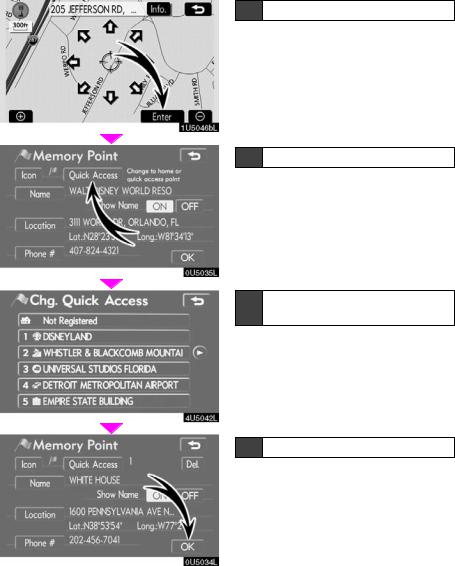
5 Touch “Enter”.
The “Memory Point” screen is displayed.
6 Touch “Quick Access”.
7Touch one of preset buttons 1 to 5.
8 Touch “OK”.
Registration of preset destinations is complete.
You can change the icon, quick access, name, location and phone number. (See “
— Editing memory points” on page 72.)
The registered points can be used on the “Destination” screen. (See “ — Destination search by Quick access” on page 22.)
x
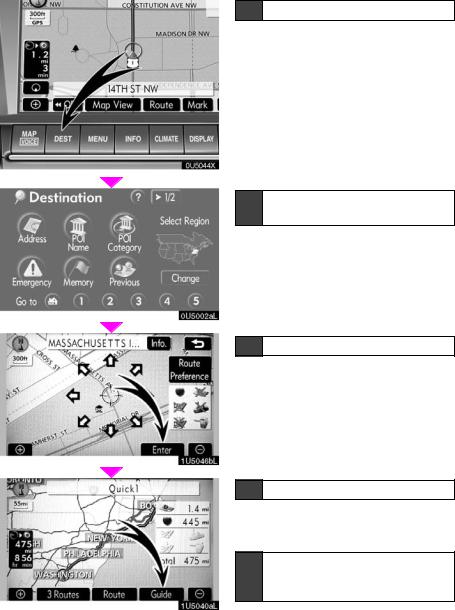
— Operation flow: guiding the route
1 Push “DEST” button.
2 There are 13 different methods to search destinations.
See “Destination search” on page 19.
3 Touch “Enter”.
The navigation system performs a search for the route.
4 Touch “Guide”, and start driving.
Routes other than the one recommended can also be selected. (See “Starting route guidance” on page 38.)
5 Guidance to the destination is given via voice and on the guidance screen.
xi
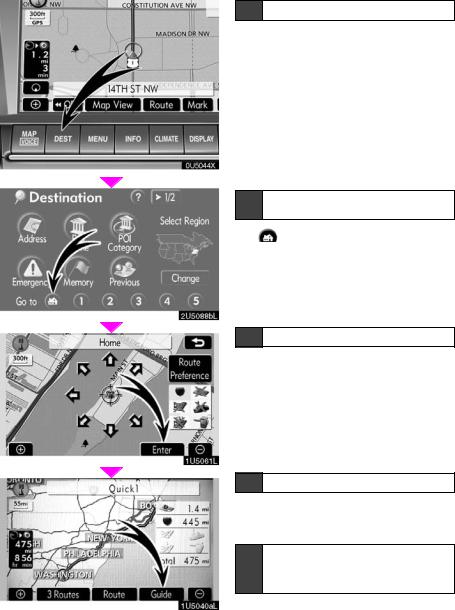
— Setting home as the destination
1 Push “DEST” button.
2 Touch  .
.
The |
can be used if your home has |
been registered. (To register “Home”, see “ — Registering home” on page 77.)
3 Touch “Enter”.
The navigation system performs a search for the route.
4 Touch “Guide”, and start driving.
Routes other than the one recommended can also be selected. (See “Starting route guidance” on page 38.)
5 Guidance to the destination is given via voice and on the guidance screen.
xii
SECTION I
BASIC FUNCTIONS
Basic information before operation
D Initial screen |
2 |
D Touch screen operation |
3 |
D Inputting letters and numbers/List screen operation |
4 |
D Function help |
7 |
D Map screen operation |
8 |
Current position display |
8 |
Screen scroll operation |
8 |
Switching the screens |
12 |
Map scale |
14 |
Foot print map |
15 |
Orientation of the map |
16 |
1
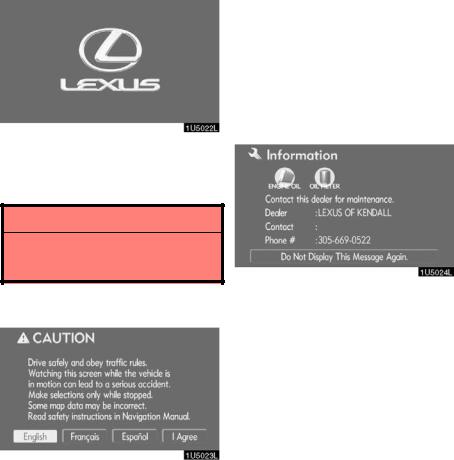
Initial screen
When the ignition switch is in the “ACC” or “ON” position, the initial screen will be displayed and the system will begin operating.
 CAUTION
CAUTION
When the vehicle is stopped with the engine running, always apply the parking brake for safety.
After a few seconds, the “CAUTION” screen will be displayed.
Touch “English”, “Français” or “Español” to select a language.
When “I Agree” is touched on the screen, the map screen will be displayed.
The “CAUTION” screen will be displayed when the “INFO” button is pushed and “Language” is touched. Then select a language. (See “Selecting a language” on page 162.)
D Maintenance information
This system informs about when to replace certain parts or components and shows dealer information (if registered) on the screen.
When the vehicle reaches a previously set driving distance or date specified for a scheduled maintenance check, the “Information” screen will be displayed when the navigation system is in operation.
To disable this screen, touch “Do Not Display This Message Again.”. This screen goes off if the screen is not operated for several seconds.
To prevent this information screen from being displayed again, touch “Do Not
Display This Message Again.”.
To register “Maintenance information”, see “Maintenance information” on page 96.
2
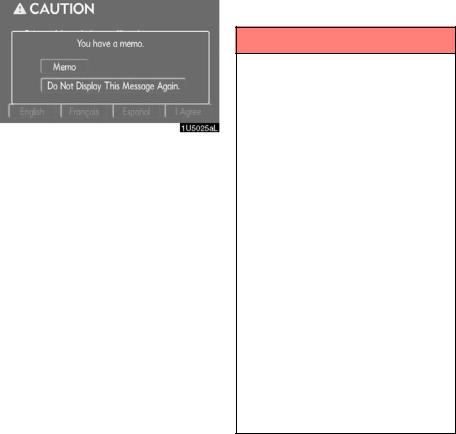
D Memo information
This system notifies about a memo entry. At the specified date, the memo information will be displayed when the navigation system is in operation. The memo information screen will be displayed every time the system is turned on.
Touch screen operation
This system is operated mainly by the touch−screen buttons on the screen.
To prevent damage to the screen, lightly touch buttons on the screen with the finger. When a button on the screen is touched, a beep sounds.
Do not use objects other than the finger to touch the screen.
The memo of the current date can be
viewed by touching “Memo”. (See “ — Editing a memo” on page 101.)
To disable this screen, touch “Do Not Display This Message Again.”. This screen goes off if the screen is not operated for several seconds.
To prevent this information screen from being displayed again, touch “Do Not
Display This Message Again.”.
To register “Memo information”, see “Calendar with memo” on page 99.
INFORMATION
DIf the system does not respond to a touch on a touch−screen button, move the finger away from the screen and then touch it again.
DDimmed touch−screen buttons cannot be operated.
DWipe off fingerprints using a glass cleaning cloth. Do not use chemical cleaners to clean the touch screen.
DThe displayed image may become darker and moving images may be slightly distorted when the display is cold.
DUnder extremely cold conditions, the map may not be displayed and the data input by a user may be deleted. Also, the touch−screen buttons may be harder than usual to depress.
DWhen you look at the screen through polarised material such as polarised sunglasses, the screen may be dark and hard to see. If so, change the angle of the screen or take off your sunglasses.
3
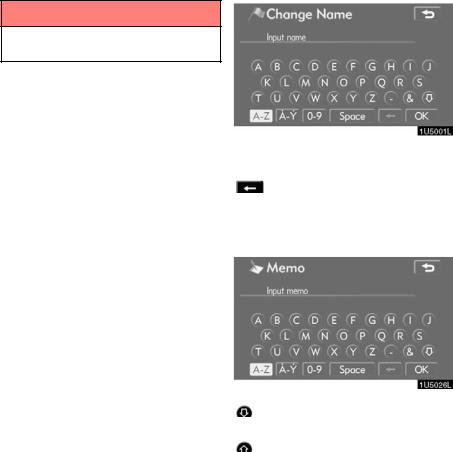
Inputting letters and numbers/List screen operation
When searching for an address or a name, or entering a memo, letters and numbers can be input via the touch screen.
INFORMATION
Keyboard layout can be changed. (See page 85.)
D To input letters
To display the alphabet keys, touch “A−Z” or “ ”.
”.
Enter letters by touching the alphabet keys directly.
:Touching this button erases one
letter. By holding this button, letters will continue to be erased.
On certain letter entry screens, letters can be entered in upper or lower case.
:
To enter in lower case.
:
To enter in upper case.
4
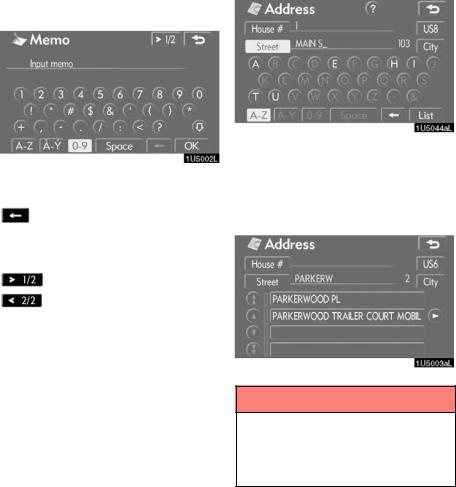
D To input numbers and symbols
To display the number keys and symbol keys, touch “0−9”.
Enter numbers and symbols by touching the number keys and symbol keys directly.
:Touching this button erases one letter. By holding this button, letters will continue to be erased.
:Touching this button displays other symbols.
D To display the list
To search for an address or a name, touch “List”. Matching items from the database are listed even if the entered address or name is incomplete.
If the number of matches is four or less, the list is displayed without touching “List”.
INFORMATION
The number of matching items is shown to the right side of the screen. If the number of matching items is
more than 9,999, the system displays “ ” on the screen.
5
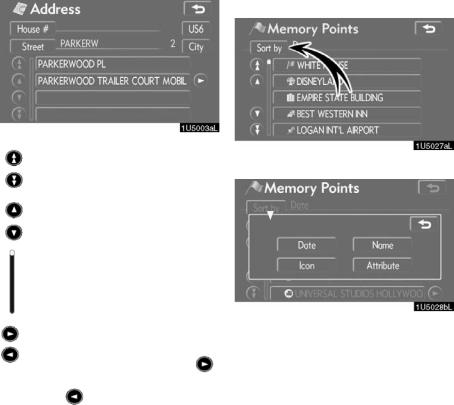
D List screen operation
When a list is displayed, use the appropriate button to scroll through the list.
To shift to the next or previous page.
To scroll up or down one item at a time.
This expresses a displayed screen position.
If  appears to the right of the item name, the complete name is too long for the display. Touch to scroll to the end of the name.
appears to the right of the item name, the complete name is too long for the display. Touch to scroll to the end of the name.
Touch |
to scroll to the beginning |
of the name.
D Sorting
The order of a list displayed on the screen can be rearranged.
TYPE A
1. Touch “Sort by”.
2. Select the desired sorting criteria.
Sorting criteria are as follows:
“Distance”: To sort in the order of distance from your current location.
“Date”: To sort in the order of the date.
“Category”: To sort in the order of the category.
“Icon”: To sort in the order of the icons. “Name”: To sort in order by name. “Attribute”: To sort in order by attribute.
6
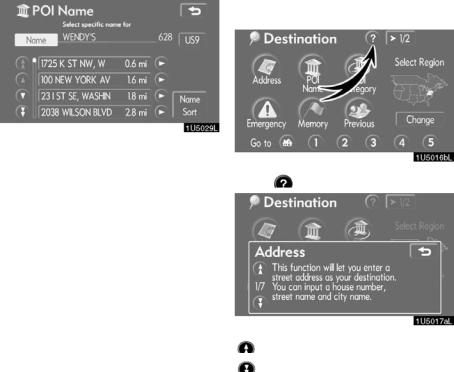
|
Function help |
TYPE B |
Explanations for the functions of the “Des- |
|
tination”, “Setup” and “Menu” screens can |
|
be viewed. |
“Dist. Sort”: To sort in the order of dis- |
|
|
tance from the current vehicle location. |
|
|
The distance from current vehicle position |
Touch |
. |
up to the destination is displayed to the |
|
|
right of the name. |
|
|
“Name Sort”: To sort in alphabetical order |
|
|
by name. |
|
|
: To view the previous page. : To view the next page.
 : To return to the previous screen.
: To return to the previous screen.
7
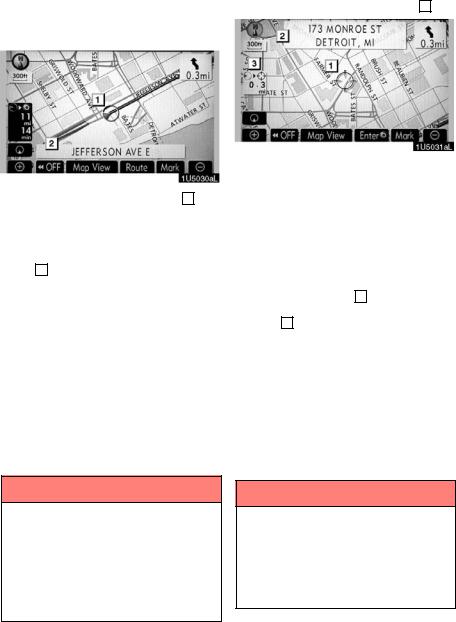
Map screen operation — |
— Screen scroll operation |
— Current position display |
(one−touch scroll) |
When starting the navigation system, the current position is displayed first.
This screen displays the current vehicle position and a map of the surrounding local area.
The current vehicle position mark ( 1 ) appears in the center or bottom center of the map screen.
A street name will appear on the bottom of the screen, depending on the scale of the map ( 2 ).
You can return to this map screen that shows your current position at any time from any screen by pushing the “MAP/ VOICE” button.
While driving, the current vehicle position mark is fixed on the screen and the map moves.
The current position is automatically set as the vehicle receives signals from the GPS (Global Positioning System). If the current position is not correct, it is automatically corrected after the vehicle receives signals from the GPS.
When any point on the map is touched, that point moves to the center of the screen and is shown by the cursor mark ( 1 ).
Use the scroll feature to move the desired point to the center of the screen for looking at a point on the map that is different from the current position of the vehicle.
If the finger is continuously held on the screen, the map will continue scrolling in that direction until the finger is removed.
A street name, city name, etc. of the touched point will be shown, depending on the scale of the map ( 2 ). Distance from the current position to 

 will also be shown ( 3 ).
will also be shown ( 3 ).
After the screen is scrolled, the map remains centered at the selected location until another function is activated. The current vehicle position mark will continue to move along your actual route and may move off the screen. When the “MAP/ VOICE” button is pushed, the current vehicle position mark returns to the center of the screen and the map moves as the vehicle proceeds along the designated route.
INFORMATION
DAfter battery disconnection, or on a new vehicle, the current position may not be correct. As soon as the system receives signals from the GPS, the correct current position is displayed.
DTo correct the current position manually, see page 91.
INFORMATION
When the one−touch scroll feature is used, the current vehicle position mark may disappear from the screen. Move the map with a one−touch scroll again or push the “MAP/VOICE” button to return to the current vehicle position map location display.
8
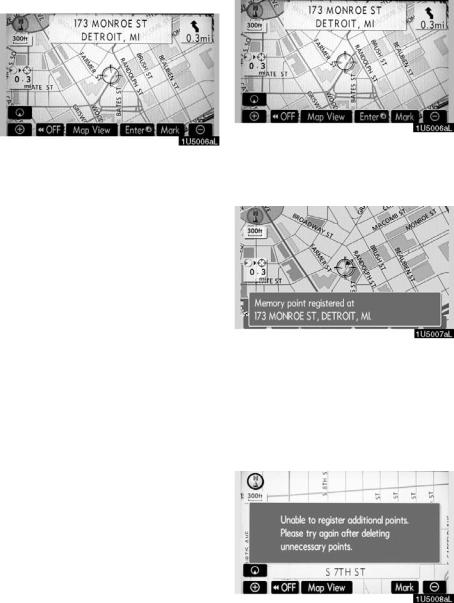
DTo set the cursor position as a destination
A specific point on the map can be set as a destination using the one−touch scroll function.
Touch “Enter ”.
”.
The screen changes and displays the map location of the selected destination and the route preference. (See “Starting route guidance” on page 38.)
DTo register the cursor position as a memory point
Memory point registration enables easy access to a specific point.
Touch “Mark”.
When you touch “Mark”, the following screen appears for a few seconds, and then the map screen returns.
The registered point is shown by  on the map.
on the map.
To change the icon or name, etc., see “ — Editing memory points” on page 72.
Up to 106 memory points can be registered. If there is an attempt to register more than 106, a message appears for confirmation.
9
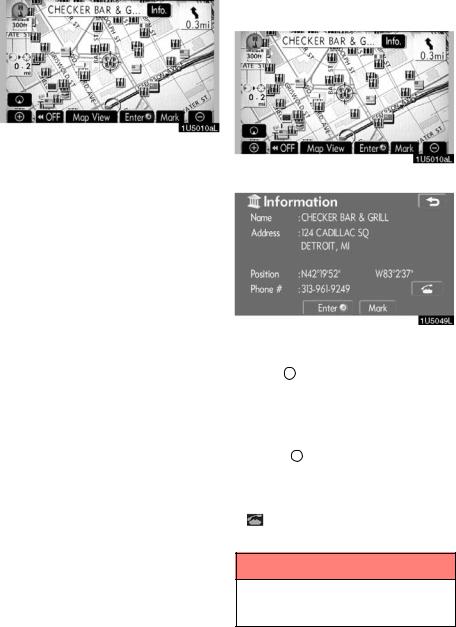
DTo see information about the icon where the cursor is set
To display information about an icon, set the cursor on it.
POI INFORMATION
When the cursor is set on a POI icon, the name and “Info.” are displayed on the top of the screen.
Touch “Info.”.
Information such as the name, address, and phone number are displayed.
If “Enter  ” is touched, the position of the cursor is set as a destination.
” is touched, the position of the cursor is set as a destination.
If there is already a set destination, “Add to ” and “Replace
” and “Replace ” are displayed.
” are displayed.
“Add to ”: To add a destination.
”: To add a destination.
“Replace  ”: To delete the existing destinations and set a new one.
”: To delete the existing destinations and set a new one.
To register this POI as a memory point, touch “Mark”. (See page 71.)
If |
is touched, the registered tele- |
phone number can be called.
INFORMATION
The desired Point of Interest can be displayed on the map screen. (See “
— Display POI icons” on page 56.)
10
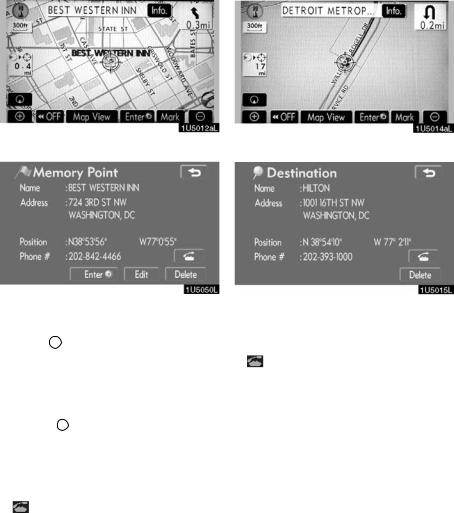
MEMORY POINT INFORMATION
When the cursor is set on a memory point icon, the name and “Info.” are displayed on the top of the screen.
Touch “Info.”.
DESTINATION INFORMATION
When the cursor is set on a destination icon, the name and “Info.” are displayed on the top of the screen.
Touch “Info.”.
Information such as the name, address, and phone number are displayed.
If “Enter  ” is touched, the position of the cursor is set as a destination.
” is touched, the position of the cursor is set as a destination.
If there is already a set destination, “Add to ” and “Replace
” and “Replace ” are displayed.
” are displayed.
“Add to ”: To add a destination.
”: To add a destination.
“Replace  ”: To delete the existing destinations and set a new one.
”: To delete the existing destinations and set a new one.
To edit a memory point, touch “Edit”. (See “ — Editing memory points” on page 72.)
To delete a memory point, touch “Delete”.
If |
is touched, the registered tele- |
phone number can be called.
Information such as the name, address, and phone number are displayed.
To delete a destination, touch “Delete”.
If |
is touched, the registered tele- |
phone number can be called.
11
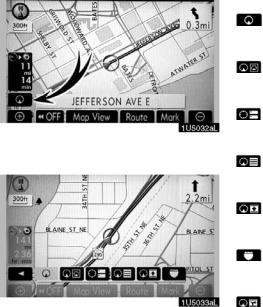
— Switching the screens
Any one of the screen configurations can be selected .
1. Touch this button to display the following screen.
2. To select the desired screen configuration, touch one of the following buttons.
Depending on the conditions, certain screen configuration buttons cannot be selected.
:
To display the single map screen. (See page 13.)
:
To display the dual map screen. (See page 13.)
:
To display the compass mode screen. (See page 14.)
:
To display the turn list screen. (See page 46.)
:
To display the arrow screen. (See page 46.)
:
To display the freeway information screen. (See page 44.)
:
To display the intersection guidance screen or the guidance screen on the freeway. (See page 45.)
12

D Screen configurations
SINGLE MAP
This is a regular map screen.
While on a different screen, touching will display the single map screen.
The screen shows the single map.
DUAL MAP
A map can be displayed split in two.
While on a different screen, touching will display the dual map screen.
The screen shows the dual map. The map on the left is the main map.
The right side map can be edited by touching any specific point on the right side map.
This screen can perform the following procedures:
1.Changing the map scale
2.Displaying the POI icon
3.Changing the orientation of the map
Touch “OK” when you complete editing.
The screen returns to the dual map screen.
13
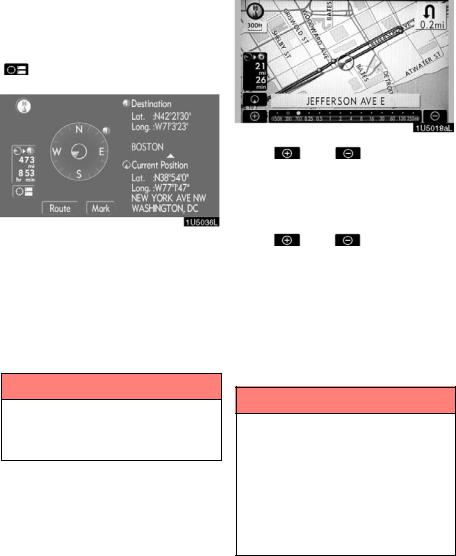
COMPASS MODE
Current vehicle position is indicated with a compass, not with a map.
While on a different screen, touching will display the compass mode
screen.
Information about the destination and current position, as well as a compass, is displayed on the screen.
The destination mark is displayed in the direction of the destination. When driving refer to the longitude and latitude coordinates, and the compass, to make sure that your vehicle is headed in the direction of the destination.
— Map scale
Touch |
or |
to change the |
scale of the map display. The scale bar and indicator at the bottom of the screen indicates the map scale menu. The scale range is 150 feet (50 m) to 250 miles (400 km).
Touch |
or |
until the scale |
bar changes normally. By continuing to touch the button, the scale bar changes smoothly.
The scale of the map display can be changed by touching the scale bar directly. It is not available while driving.
The map scale is displayed under the north−up symbol or heading−up symbol at the top left of the screen.
INFORMATION
When the vehicle travels out of the coverage area, the guidance screen changes to the compass mode screen.
INFORMATION
When the map scale is at the maximum range of 250 miles (400 km),  is not shown. When the map scale is at the minimum range of 150 feet (50 m),
is not shown. When the map scale is at the minimum range of 150 feet (50 m),  is not shown. In areas where the foot print map is available the map scale changes from
is not shown. In areas where the foot print map is available the map scale changes from  to
to  when at the minimum range.
when at the minimum range.
14
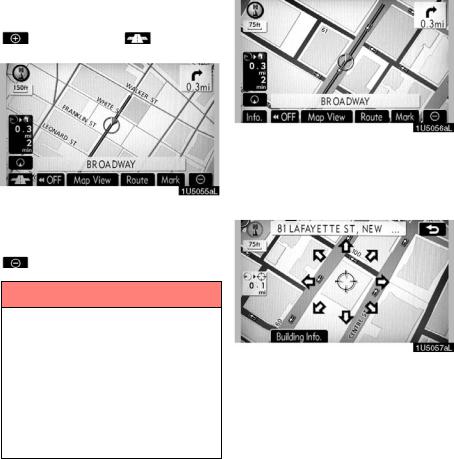
Foot print map
For the area which is covered by the foot print map (Some areas in the following cities: Detroit, Chicago, N.Y., L.A), you can switch to the foot print map on a scale of 75 feet (25 m).
D To switch to the foot print map
changes into |
when the |
map is scaled down to 150 feet (50 m).
To display the foot print map, touch  .
.
To delete the foot print map display, touch
.
INFORMATION
DIf the map or the current position is moved to the area which is not covered by the foot print map, the screen scale automatically changes to 150 feet (50 m).
DOn the foot print map, a one way street is displayed by  .
.
DIt is not possible to perform scrolling on the foot print map (one− touch scroll) while driving.
D To display building information
Information is available only for buildings for which information is recorded on the map disc.
1. Touch “Info.” while the foot print map is displayed.
If the map is displayed by a split screen, the map will change into a single map display.
2.Using the eight−direction arrow, move the cursor to the position of the building to display building information.
3.Touch “Building Info.”.
15
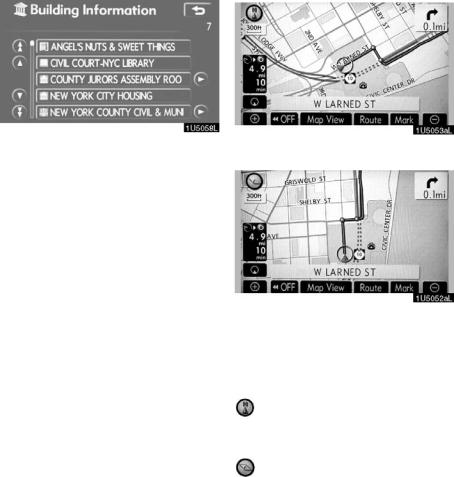
— Orientation of the map
Details of POIs in some buildings may be displayed.
For detailed POI information, touch the building name. You can see details of the selected POIs.
" North−up screen
" Heading−up screen
The orientation of the map can be changed from North−up to Heading−up by touching the orientation symbol at the top left of the screen.
North−up symbol
Regardless of the direction of vehicle travel, North is always up.
Heading−up symbol
The direction of vehicle travel is always up. A red arrow indicates North.
16
SECTION |
II |
DESTINATION SEARCH |
|
Destination search |
|
D Quick reference (“Destination” screen) |
18 |
D Destination search |
19 |
Selecting the region to search |
20 |
Destination search by Home |
22 |
Destination search by Quick access |
22 |
Destination search by “Address” |
23 |
Destination search by “POI Name” |
27 |
Destination search by “POI Category” |
30 |
Destination search by “Emergency” |
33 |
Destination search by “Memory” |
34 |
Destination search by “Previous” |
34 |
Destination search by “Map” |
35 |
Destination search by “Intersection” |
35 |
Destination search by “Freeway Ent./Exit” |
36 |
Destination search by “Coordinates” |
37 |
Destination search by “Phone #” |
38 |
D Starting route guidance |
38 |
17
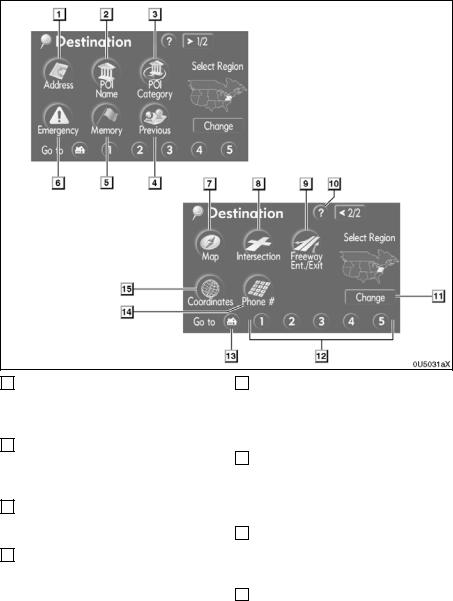
Quick reference (“Destination” screen)
1 “Address”
A house number and the street address can be input by using the input keys.
. . . . . . . . . . . . . . . . . . . . . . . . . . . . . . . . . . 23
2 “POI Name”
Select one of the many POIs (Points of Interest) that have already been stored in the system’s database. . . . . . . . . . . . . . . . . 27
3 “POI Category”
A destination can be selected from the POI category. . . . . . . . . . . . . . . . . . . . . . . . . . 30
4 “Previous”
A destination can be selected from any of the last 100 previously set destinations and from the previous starting point.
. . . . . . . . . . . . . . . . . . . . . . . . . . . . . . . . . . 34
5 “Memory”
The location can be selected from the registered “Memory points”. (To register memory points, see “ — Registering memory points” on page 71.) . . . . . . . . 34
6 “Emergency”
One of the four categories of emergency service points that are already stored in the system’s database can be selected.
. . . . . . . . . . . . . . . . . . . . . . . . . . . . . . . . . . 33
7 “Map”
A destination can be selected simply by touching the location on the displayed map. . . . . . . . . . . . . . . . . . . . . . . . . . . . . . 35
8 “Intersection”
The names of two intersecting streets can be entered. This is helpful if only the general vicinity, not the specific address, is known. . . . . . . . . . . . . . . . . . . . . . . . . . . . 35
18
